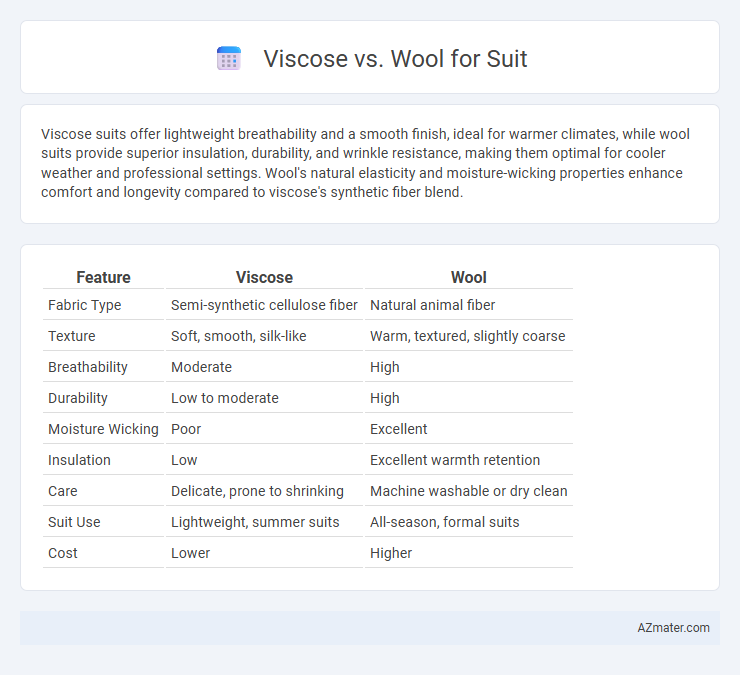Viscose suits offer lightweight breathability and a smooth finish, ideal for warmer climates, while wool suits provide superior insulation, durability, and wrinkle resistance, making them optimal for cooler weather and professional settings. Wool's natural elasticity and moisture-wicking properties enhance comfort and longevity compared to viscose's synthetic fiber blend.
Table of Comparison
| Feature | Viscose | Wool |
|---|---|---|
| Fabric Type | Semi-synthetic cellulose fiber | Natural animal fiber |
| Texture | Soft, smooth, silk-like | Warm, textured, slightly coarse |
| Breathability | Moderate | High |
| Durability | Low to moderate | High |
| Moisture Wicking | Poor | Excellent |
| Insulation | Low | Excellent warmth retention |
| Care | Delicate, prone to shrinking | Machine washable or dry clean |
| Suit Use | Lightweight, summer suits | All-season, formal suits |
| Cost | Lower | Higher |
Introduction to Viscose and Wool
Viscose is a semi-synthetic fiber derived from cellulose, offering a silky texture and excellent breathability that makes it popular for lightweight suits. Wool, a natural protein fiber obtained from sheep, provides superior insulation, durability, and a classic drape ideal for formal suits. Both fibers cater to different climate needs and style preferences, with viscose favored for warmer weather and wool preferred for its warmth and resilience.
Origin and Production Process
Viscose is a semi-synthetic fiber derived from chemically treated wood pulp, primarily sourced from fast-growing trees like eucalyptus and beech, making its production reliant on both natural resources and chemical processes. Wool, on the other hand, is a natural protein fiber harvested from sheep through shearing, with processing involving cleaning, carding, and spinning to produce the fabric. The production of viscose involves dissolving cellulose to regenerate fibers in a controlled environment, whereas wool processing preserves the fiber's natural crimp and insulating properties, reflecting their distinct origins and manufacturing methods.
Texture and Appearance Comparison
Viscose suits offer a smooth, silky texture with a subtle sheen that creates a lightweight, breathable feel ideal for warmer climates or formal events. Wool suits provide a rich, natural texture with a matte finish, known for excellent wrinkle resistance and warmth, making them suitable for colder weather and professional settings. The drape of viscose tends to be softer and more fluid, while wool maintains a structured, tailored appearance that enhances sharpness and longevity.
Comfort and Breathability
Viscose suits offer high breathability due to their semi-synthetic cellulose fibers, making them comfortable in warm climates by promoting moisture absorption and preventing overheating. Wool suits provide superior insulation and natural temperature regulation, adapting to both warm and cool conditions while offering excellent breathability through their crimped fiber structure. For long-lasting comfort, wool suits excel in moisture-wicking and durability, whereas viscose suits are softer but less resilient under heavy wear.
Durability and Longevity
Viscose suits offer moderate durability but tend to wear out faster due to fiber degradation and lower resistance to abrasion compared to wool. Wool suits exhibit superior longevity, with natural resilience, elasticity, and moisture-wicking properties that maintain fabric integrity over time. For long-lasting, durable suits, wool remains the preferred material, especially in high-quality, tailored garments.
Maintenance and Care Requirements
Viscose suits require gentle washing with mild detergents and often need professional dry cleaning to maintain fabric integrity and prevent shrinking. Wool suits demand more meticulous care, including regular brushing to remove dirt, airing to reduce odors, and expert dry cleaning to preserve the natural fibers and prevent felting. Both fabrics benefit from proper storage using padded hangers and breathable garment bags to avoid moisture buildup and maintain shape.
Cost and Affordability
Viscose suits typically cost less than wool suits due to lower raw material and production expenses, making them a budget-friendly option for stylish attire. Wool suits, while more expensive, offer superior durability, natural breathability, and a refined appearance that justifies the higher price point for long-term investment. Selecting between viscose and wool depends on balancing upfront affordability with suit longevity and fabric performance.
Environmental Impact
Viscose production relies heavily on chemically intensive processes and deforestation, leading to habitat destruction and significant water pollution. Wool is a renewable resource with biodegradability and natural insulation properties, but its environmental cost includes methane emissions and land use impact from sheep farming. Choosing between viscose and wool requires balancing viscose's resource-intensive manufacturing against wool's greenhouse gas emissions and ethical considerations in animal farming.
Suitability for Different Occasions
Viscose suits offer a lightweight, breathable option ideal for warm-weather events or casual gatherings, providing a smooth drape with a silk-like appearance. Wool suits excel in versatility, offering thermal regulation and durability suitable for formal occasions, business settings, and colder climates. Choosing between viscose and wool depends on the event's formality and environmental conditions, where wool is preferred for year-round professional wear, while viscose suits suit stylish, less formal settings.
Final Verdict: Choosing Between Viscose and Wool
Viscose suits offer a lightweight and breathable option ideal for warmer climates, while wool suits provide superior insulation, durability, and natural wrinkle resistance, making them suitable for colder environments and formal occasions. Wool's ability to regulate temperature and resist odors outperforms viscose in long-term wear and maintenance. For a refined, versatile suit that balances comfort and longevity, wool remains the preferred choice, whereas viscose suits serve well for budget-friendly, stylish options in milder conditions.

Infographic: Viscose vs Wool for Suit
 azmater.com
azmater.com